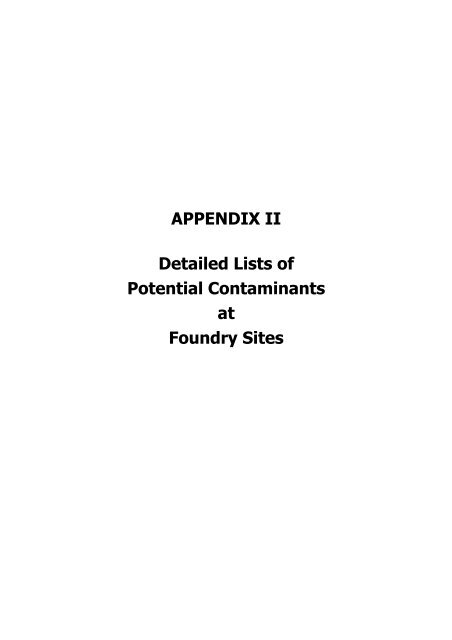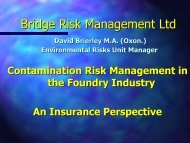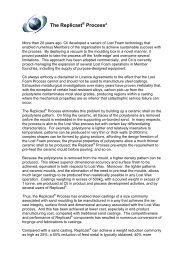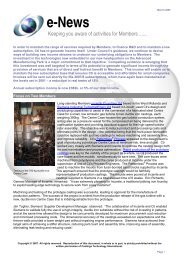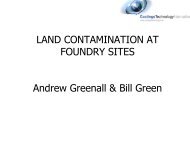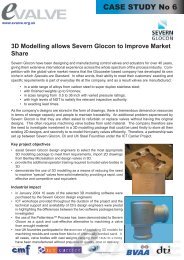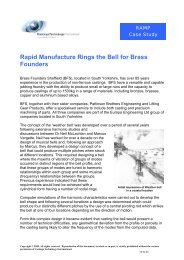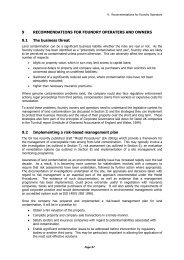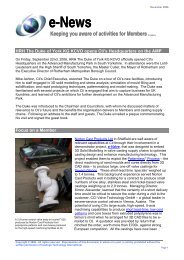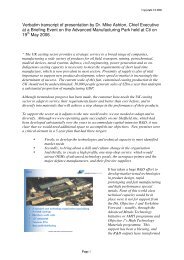APPENDIX II Detailed Lists of Potential Contaminants at Foundry Sites
APPENDIX II Detailed Lists of Potential Contaminants at Foundry Sites
APPENDIX II Detailed Lists of Potential Contaminants at Foundry Sites
You also want an ePaper? Increase the reach of your titles
YUMPU automatically turns print PDFs into web optimized ePapers that Google loves.
<strong>APPENDIX</strong> <strong>II</strong><br />
<strong>Detailed</strong> <strong>Lists</strong> <strong>of</strong><br />
<strong>Potential</strong> <strong>Contaminants</strong><br />
<strong>at</strong><br />
<strong>Foundry</strong> <strong>Sites</strong>
Appendix <strong>II</strong><br />
1. <strong>Potential</strong> <strong>Contaminants</strong> Deposited By Air Emissions from Ferrous <strong>Foundry</strong> Melting Processes<br />
Emissions from Melting Fuels * Emissions from Charge M<strong>at</strong>erials Metal Tre<strong>at</strong>ment<br />
Metals &<br />
Metalloids: Coal Coke I Coal<br />
<strong>Contaminants</strong> Ferrous Alloy<br />
Oil<br />
Gas<br />
Fluxes Desulphuris<strong>at</strong>ion I Nodularis<strong>at</strong>ion I Bessemer Process/<br />
gas<br />
in Scrap Constituents<br />
Oxygen Lancing S<br />
Sb L L L T D/T<br />
As L L L P D/T<br />
Ba L L L<br />
Be T T T<br />
Bi P D/T<br />
B P P D/T<br />
Ca D/T P L<br />
Cd L L L T L<br />
Cr L L L T D<br />
Co L L L D<br />
Cu L L L T P D (may be T)<br />
Fe L L L C C C C<br />
Pb L L L T L D<br />
Hg L T? L P T<br />
Mg L L L D/T P C<br />
Mn L L L L L L L<br />
Mo L L L T D<br />
Ni L L L T D<br />
Se L L L<br />
Ti L L P D/T<br />
V L L L T D<br />
Zn L L L T L<br />
OTHER:<br />
Cl & cmpds C C L P? P<br />
PCDD/F L L P<br />
F & cmpds L L L P P P<br />
Na & cmpds P<br />
PAH C C C P L<br />
S & cmpds C C L C T C P<br />
Key: * where used. From l<strong>at</strong>e 19 th century, electric melting methods were also in use in UK & are now the predominant technologies.<br />
C: certain, i.e., always expected L: likely P: possible T: trace only D: dependant on alloys under production<br />
Historic processes only, not used in ferrous foundries currently I: Iron foundries only S: Steel foundries only<br />
Page <strong>II</strong>-i
Appendix <strong>II</strong><br />
2. <strong>Potential</strong> <strong>Contaminants</strong> Deposited By Air Emissions from other Ferrous <strong>Foundry</strong> Processes<br />
Casting in Sand Moulds Knockout from Sand Moulds Fettling Sand Reclaim<br />
Phenolic<br />
bonded<br />
Silic<strong>at</strong>e<br />
bonded<br />
Phenolic<br />
bonded<br />
Silic<strong>at</strong>e<br />
bonded<br />
Other<br />
Mould &<br />
Coremaking*<br />
Oilsand<br />
Resin<br />
Shell<br />
Greensand<br />
Greensand<br />
Shotblasting<br />
Greensand<br />
Phenolic<br />
bonded<br />
Metals & Metalloids:<br />
Sb D/T D<br />
Bi D/T D<br />
Cr D D<br />
Co D D<br />
Cu D/T D<br />
Fe C C<br />
Mn L D<br />
Mo D D<br />
Ni D D<br />
V D D<br />
OTHER:<br />
SiO 2 dust P P P C L L L P/T C L L<br />
Zircon dust S #<br />
P P P P D P/T P<br />
Chromite sand dust S P P P P D P/T P<br />
Coaldust I P C D C<br />
Clay dust P C D C<br />
Phenolics on dust C C C P C C<br />
PAH on dust L C C C P C C T P C C<br />
Sulphur & compounds F F F<br />
Key: * Oil-sand, loam & dry sand mould/core making processes involve drying in an oven, which may be gas or oil-fired.<br />
See list 1 for associ<strong>at</strong>ed contaminants from the fuel use.<br />
C: certain, i.e., always expected L: likely P: possible T: trace only D: dependant on process/alloy F: S-c<strong>at</strong>alysed furans only<br />
# Contains trace amounts <strong>of</strong> radioactive isotopes<br />
I: Iron foundries only S: Steel foundries only<br />
Silic<strong>at</strong>e<br />
bonded<br />
Page <strong>II</strong>-ii
Appendix <strong>II</strong><br />
3. <strong>Potential</strong> <strong>Contaminants</strong> to Land from <strong>Foundry</strong> Raw M<strong>at</strong>erials Storage,<br />
Handling & Use in Process<br />
PROCESS<br />
AREA<br />
RAW MATERIAL FORM/CONTAINER COMMENTS<br />
PATTERN<br />
SHOP<br />
MOULD &<br />
COREMAKING<br />
MELTING<br />
HEAT<br />
TREATMENT<br />
CASTING<br />
PAINTING<br />
SOLID MATERIALS<br />
Wood & dust<br />
LIQUID MATERIALS<br />
Glues & adhesives Tins, aerosols P: usually small amounts<br />
Paints & Thinners Tins P: usually 0.5 – 200 l sizes<br />
Epoxy resins & hardeners Tins P: usually small amounts<br />
Fibreglass resins<br />
P<br />
SOLID MATERIALS<br />
Silica sand & dust<br />
Zircon sand, flour & dust #<br />
Chromite sand & dust S<br />
Resin shell sand <br />
Clay<br />
Coaldust I<br />
LIQUID MATERIALS<br />
Silos, hoppers,<br />
1-t bags, 50 kg sacks,<br />
open compounds<br />
(internal or extermal)<br />
L<br />
L: normally in bulk<br />
P: usually smaller amounts<br />
P: usually smaller amounts<br />
P<br />
P<br />
P<br />
Glues & adhesives Tins, aerosols L: usually small amounts<br />
Isopropyl alcohol Tins, drums, IBC’s L<br />
IPA-based mould co<strong>at</strong>ings Drums, IBC’s, bulk tanks L: usually contains Zr<br />
Resins & Hardeners * Drums, IBC’s, bulk tanks L<br />
Gas Oil Bulk tanks P: used for curing ovens<br />
Lubric<strong>at</strong>ing Oil Drums P: for moulding equipment<br />
SOLID MATERIALS<br />
Silica sand Bags or open compounds P: for pigging <strong>of</strong> metal<br />
Coke I<br />
C for cupola/blast furnaces<br />
Internal or external<br />
Coal<br />
P for crucible/reverber<strong>at</strong>ory furnaces<br />
storage compounds<br />
Limestone/dolomite<br />
P<br />
Refractory m<strong>at</strong>erials Solids & powders in bags C<br />
Calcium carbide I<br />
Sealed drums<br />
CaO/CaF I<br />
P: only present where malleable or<br />
Sodium Carbon<strong>at</strong>e I<br />
Drums, bags<br />
ductile iron were/are made<br />
Metal returns<br />
Bins, compounds, piles<br />
C<br />
Scrap **<br />
(internal or external; on L: may be contamin<strong>at</strong>ed with liquids<br />
Pig iron/ingot/bar soil or hardstandings)<br />
L<br />
Ferro-alloys<br />
Solids, pellets, etc. in<br />
L<br />
Other additions<br />
drums or bags<br />
L<br />
Insul<strong>at</strong>ing wools Blanket sheets P: may contain RFC’s<br />
LIQUID MATERIALS<br />
Gas Oil Bulk tanks P: where used as melting fuel<br />
Lubric<strong>at</strong>ing Oil Drums P: for hydraulic furnace controls<br />
Transformer Oil Drums L: PCB contamin<strong>at</strong>ion possible <br />
SOLID MATERIALS<br />
Insul<strong>at</strong>ing wools Blanket sheets P: may contain RFC’s<br />
LIQUID MATERIALS<br />
Quench oil Bulk tanks (open) P<br />
Chlorin<strong>at</strong>ed solvents Drums, tanks P: for degreasing<br />
SOLID MATERIALS<br />
Zinc wire Drums P<br />
Other metals/co<strong>at</strong>ings Powders in drums P<br />
Page <strong>II</strong>-iii
Appendix <strong>II</strong><br />
PROCESS<br />
AREA<br />
CASTING<br />
PAINTING<br />
ANCILLARY<br />
OPERATIONS<br />
RAW MATERIAL FORM/CONTAINER COMMENTS<br />
LIQUID MATERIALS<br />
Paints<br />
Thinners<br />
LIQUID MATERIALS<br />
Tins, drums, IBCs<br />
P: most common solvents are xylene,<br />
white spirit, toluene, MEK<br />
Diesel Bulk tanks L: for forklift trucks<br />
Petrol Bulk tanks P: for vehicle refueling<br />
Lubric<strong>at</strong>ing & hydraulic oils Tins, drums<br />
L: equipment & vehicle maintenance;<br />
foundry plant, machining oper<strong>at</strong>ions<br />
PCB containing oils<br />
In equipment<br />
L: capacitors in electric motors,<br />
fluorescent lights, hydraulic<br />
equipment & process he<strong>at</strong>ing plant<br />
Solvent based products Tins, aerosols, tanks P: used in non-destructive testing<br />
Coolants & cutting fluids Drums, IBCs, bulk tanks P: Machining oper<strong>at</strong>ions<br />
Biocides<br />
Drums, tanks<br />
L: for control <strong>of</strong> cooling systems<br />
P: use for control <strong>of</strong> machining fluids<br />
Corrosion inhibitors<br />
Drums, tanks, tins<br />
L: for control <strong>of</strong> cooling systems<br />
P: use on finished castings<br />
Key:<br />
C: certain L: likely P: possible RFCs: Refractory ceramic fibres<br />
I: Iron foundries only S: Steel foundries only<br />
* See detailed list 3(a) below ** See detailed list 3(b) below<br />
# Contains trace amounts <strong>of</strong> radioactive isotopes<br />
A free flowing sand pre-co<strong>at</strong>ed with a phenol formaldehyde novolak resin, which contains a<br />
hexamine curing agent. Process first introduced in 1950’s.<br />
PCBs can also be found in large booster vacuum pumps installed between 1960 & 1970, as well as<br />
in some imported ring jet pumps<br />
May include chlorin<strong>at</strong>ed products<br />
Page <strong>II</strong>-iv
Appendix <strong>II</strong><br />
3(a) Mould & Coremaking Resins, Hardeners & C<strong>at</strong>alysts<br />
BINDER<br />
SYSTEM<br />
FIRST<br />
USE<br />
SETTING<br />
METHODS<br />
RESIN CONSTITUENTS<br />
HARDENER/CATALYST<br />
CONSTITUENTS<br />
Alkaline<br />
phenolic *<br />
1984/5<br />
Self-set,<br />
gassed<br />
Aqueous alkaline K or Na-based<br />
phenol formaldehyde resin; can<br />
contain methanol<br />
Self-set: organic esters<br />
Gassed: methyl form<strong>at</strong>e or CO 2<br />
Alkyd<br />
urethane<br />
1960’s Self-set<br />
Part 1: drying oil modified alkyd<br />
(polyester)<br />
Part 2: polyisocyan<strong>at</strong>e<br />
Cobalt naphthen<strong>at</strong>e (commonly<br />
incorpor<strong>at</strong>ed in Part 1)<br />
Ecolotec 1990’s Gassed Alkaline phenolic resin CO 2<br />
SO 2 cured<br />
epoxy resin<br />
1983 Gassed<br />
Modified epoxy resin mixed with<br />
an organic hydroperoxide; a<br />
furan version (from 1975) is also<br />
available<br />
Sulphur dioxide gas<br />
Free radical 1990’s Gassed<br />
Furan * 1958 Self-set<br />
Uns<strong>at</strong>ur<strong>at</strong>ed urethane oligomers<br />
& acrylic monomers, with an<br />
organic peroxide<br />
Urea formaldehyde (UF), phenol<br />
formaldehyde (PF) & furfuryl<br />
alcohol (FA) resin mixtures<br />
Sulphur dioxide gas<br />
Para-toluene, xylene or benzene<br />
sulphonic acids, sulphuric acids &<br />
phosphoric acid, or mixtures.<br />
Hotbox 1960 He<strong>at</strong><br />
Methylal<br />
cured<br />
phenolic resin<br />
mid-<br />
1980’s<br />
Gassed<br />
Phenolic (PF) and urea furan (UF)<br />
resins<br />
Phenolic resin<br />
No-bake oils 1950’s Self-set Esterfied or alkyd oil<br />
Oil sand **<br />
Phenolic<br />
urethane *<br />
Pre-<br />
1900<br />
1968-<br />
70<br />
Polidox 1980’s<br />
He<strong>at</strong><br />
Self-set,<br />
gassed<br />
Self-set,<br />
gassed<br />
Resin shell * 1950 He<strong>at</strong><br />
Ammonium chloride, urea & acid<br />
salts<br />
Methylal vapour with a toluene<br />
sulphonic acid c<strong>at</strong>alyst<br />
Sodium perbor<strong>at</strong>e or polymeric<br />
isocyan<strong>at</strong>e<br />
Modified vegetable oils & dextrin emulsions<br />
Part 1: phenol formaldehyde<br />
resin in ester/arom<strong>at</strong>ic<br />
hydrocarbon solvents<br />
Part 2: Isocyan<strong>at</strong>e, e.g., MDI<br />
Self-set: liquid tertiary amine,<br />
e.g., phenylpropylpyridine<br />
Gassed: dimethylethylamine or<br />
triethylamine<br />
Sodium polyacryl<strong>at</strong>e Alkaline powder & CO 2<br />
Mostly supplied as dry co<strong>at</strong>ed<br />
sand, but phenol novolak resin<br />
liquid in methanol, shellacs,<br />
waxes (if sand co<strong>at</strong>ed <strong>at</strong> foundry)<br />
hexamine<br />
Silic<strong>at</strong>e * 1952<br />
Self-set,<br />
gassed<br />
Sodium silic<strong>at</strong>e solutions<br />
containing SiO 2 and Na 2 O in<br />
varying proportions<br />
Self-set: organic esters<br />
Gassed: CO 2<br />
Warm box 1978 He<strong>at</strong> Furan resins<br />
Copper salts or inorganic salts <strong>of</strong><br />
sulphonic acid<br />
* most common current systems ** commonly used historically for core making<br />
Note: The term “self-set” is used to describe systems th<strong>at</strong> cure <strong>at</strong> room temper<strong>at</strong>ure after the resin<br />
and liquid hardener are mixed together with the sand.<br />
Page <strong>II</strong>-v
Appendix <strong>II</strong><br />
3 (b) Contamin<strong>at</strong>ion <strong>Potential</strong> <strong>of</strong> Pig Iron & Ferro Alloys<br />
MATERIAL/FORM<br />
POTENTIAL ENVIRONMENTAL IMPACTS<br />
STORAGE ISSUES<br />
MELTING<br />
Pig Iron – solid “pigs”<br />
Ferro Alloys – supplied as lumps,<br />
granules, or powders<br />
Ferro Boron<br />
Ferro Molybdenum<br />
Ferro Niobium<br />
Ferro Titanium<br />
Ferro Vanadium<br />
Ferro Silico Chrome<br />
Ferro Silicon Alloys<br />
Ferro Tungsten<br />
High Carbon Ferro Chrome<br />
Low Carbon Ferro Chrome<br />
Other Ferro Alloys – supplied as<br />
lumps, granules, or powders<br />
Ferro Manganese<br />
Ferro Silicon Zirconium<br />
Ferro Phosphorus<br />
Ferro Silicon<br />
Ferro Sulphur<br />
Magnesium Ferro Silicon<br />
None<br />
M<strong>at</strong>erials are stable, inert and insoluble<br />
in supplied form.<br />
Spillage, particularly <strong>of</strong> powders, could<br />
result in localised metals contamin<strong>at</strong>ion<br />
<strong>of</strong> the ground surface, but leaching into<br />
groundw<strong>at</strong>er is improbable.<br />
Spillages should be prevented from<br />
entering drains and w<strong>at</strong>ercourses.<br />
As above, with specific hazards listed<br />
below<br />
Exposure to air can result in form<strong>at</strong>ion<br />
<strong>of</strong> manganese carbide, which reacts<br />
with w<strong>at</strong>er to give explosive gases<br />
including hydrogen.<br />
Slightly soluble in w<strong>at</strong>er, some leaching<br />
into groundw<strong>at</strong>er following spillage is<br />
possible.<br />
Contact with moisture can result in<br />
evolution <strong>of</strong> arsine, phosphine, or<br />
hydrogen. Forms corrosive solution on<br />
contact with acids.<br />
Contact with moisture can result in<br />
evolution <strong>of</strong> hydrogen, arsine or<br />
phosphine<br />
Soluble in acids, which can result in<br />
release <strong>of</strong> H 2 S gas.<br />
Slightly soluble in w<strong>at</strong>er, some leaching<br />
into groundw<strong>at</strong>er following spillage is<br />
possible. Contact with moisture can<br />
result in evolution <strong>of</strong> hydrogen, arsine<br />
or phosphine<br />
Will contribute to Fe/Mn<br />
releases<br />
Will contribute small amounts<br />
to air emissions, depending on<br />
melting/boiling point<br />
properties, but is added to melt<br />
by methods th<strong>at</strong> ensure<br />
maximum recovery in the metal<br />
being produced.<br />
Thermal decomposition<br />
produces SO x and H 2 S gases.<br />
Page <strong>II</strong>-vi
Appendix <strong>II</strong><br />
4. <strong>Potential</strong> <strong>Contaminants</strong> to Land from Ferrous <strong>Foundry</strong> Wastes<br />
A variety <strong>of</strong> wastes are gener<strong>at</strong>ed during the foundry process. The quality <strong>of</strong> waste management also<br />
varies considerably around the modern industry and poor management was common in the past.<br />
Where sufficient space was available, waste may have been deposited directly on the property, in a<br />
company landfill, or left around on an ad hoc basis, inside or outside <strong>of</strong> buildings. Most companies<br />
now have some design<strong>at</strong>ed storage areas, although bunding <strong>of</strong> empty drums, etc. is still unusual.<br />
Note th<strong>at</strong> the key for this table refers to whether the process will gener<strong>at</strong>e these wastes or not.<br />
Whether the wastes or associ<strong>at</strong>ed residues may still be present <strong>at</strong> a site or not will depend entirely on<br />
waste management practices over the years. Any <strong>of</strong> the waste streams listed may also contain other<br />
m<strong>at</strong>erials, e.g., discarded gloves, packaging wastes, etc., depending on the extent <strong>of</strong> segreg<strong>at</strong>ion<br />
practised/not practised <strong>at</strong> the site.<br />
Key to Whether Waste is Gener<strong>at</strong>ed by the Process: C: certain L: likely P: possible<br />
PROCESS<br />
AREA<br />
WASTE CONTAMINANTS COMMENTS<br />
ALL AREAS<br />
SOLID MATERIALS<br />
LIQUID MATERIALS<br />
SOLID MATERIALS<br />
Any form as received may be disposed <strong>of</strong> due to damage, spillage,<br />
etc. Dusts from processing & use <strong>of</strong> m<strong>at</strong>erials may also be present,<br />
e.g., sand dust, wood dust. Packaging wastes <strong>of</strong> all types are also<br />
found.<br />
Any m<strong>at</strong>erials arriving on site may eventually end up as waste. Full<br />
containers <strong>of</strong> resins, paints, oils, etc. may be discarded if the<br />
m<strong>at</strong>erial becomes <strong>of</strong>f spec, or is no longer required. Partially filled<br />
or “empty” containers will be gener<strong>at</strong>ed as waste from many areas.<br />
Historically, there is a high potential th<strong>at</strong> such wastes were poorly<br />
managed & spillage or leaks into soil may be expected.<br />
Waste mixed sand<br />
Mixer scrapings<br />
Floor sweepings<br />
Scrap moulds/cores<br />
Uncured resins<br />
Cured resins<br />
C: May or may not be segreg<strong>at</strong>ed.<br />
M<strong>at</strong>erials tend to be high in<br />
leachable phenolics, arom<strong>at</strong>ics, etc.<br />
depending on the binder system.<br />
Silo filter dust<br />
M<strong>at</strong>erial dependant, e.g.,<br />
SiO 2 dust if silica sand<br />
C: where filtr<strong>at</strong>ion used<br />
Cast/knocked out sand<br />
(largest foundry waste by<br />
volume)<br />
Sand dust, residual binders,<br />
PAH, fine metallic drops from<br />
alloys<br />
C: leach<strong>at</strong>e levels considerably<br />
lower than for uncast sands due to<br />
burn out. pH varies (2.5-12)<br />
SAND<br />
SYSTEM<br />
WASTES<br />
ABATEMENT WASTES<br />
Dusts/sludge – knockout<br />
Greensand plants (in past,<br />
usually wet plants)<br />
Chemically bonded sand<br />
reclam<strong>at</strong>ion (usually dry)<br />
SiO 2 & binder residues<br />
(greensand or chemical)<br />
SiO 2 , clay & coal dusts<br />
SiO 2 (or Zircon) & resin rich<br />
dusts<br />
C: plants can be wet or dry, which<br />
can affect likely spillage p<strong>at</strong>terns &<br />
control issues<br />
(Dry bag filtr<strong>at</strong>ion is now the<br />
predominant type)<br />
Thermal sand reclaim (dry) SiO 2 dusts (or Zircon) C<br />
LIQUID WASTES<br />
See comments under All Areas<br />
Scrubber liquor<br />
Amine, spent phosphoric or<br />
sulphuric acid and amine,<br />
sulph<strong>at</strong>es/phosph<strong>at</strong>es<br />
P: where gas-cured urethane<br />
systems are in use<br />
Page <strong>II</strong>-vii
Appendix <strong>II</strong><br />
PROCESS<br />
AREA<br />
WASTE CONTAMINANTS COMMENTS<br />
MELTING<br />
FETTLING<br />
ANCILLARY<br />
OPERATIONS<br />
SOLID MATERIALS<br />
Cupola Bottom Ash Coke dust, metals C: if cupola melting used<br />
Clinker<br />
Sintered limestone with iron<br />
oxides<br />
C: if blast furnace used<br />
Melting slag<br />
CaO/ MgO, metals, sulphur<br />
C: Variety <strong>of</strong> types (e.g., air-cooled,<br />
w<strong>at</strong>er granul<strong>at</strong>ed) & form differs<br />
according to the melting furnace.<br />
Physically unstable if oxides are not<br />
fully hydr<strong>at</strong>ed; S where present may<br />
be leachable.<br />
Desulphuris<strong>at</strong>ion slag<br />
CaO / Ca carbide residues,<br />
high sulphur, v. alkaline – pH<br />
12-13<br />
P: Physically & chemically unstable<br />
until oxide/carbide is fully<br />
hydr<strong>at</strong>ed/reacted.<br />
Refractories from furnaces Can be alkaline, although<br />
& ladles<br />
largely inert<br />
C<br />
Refractories from<br />
nodularis<strong>at</strong>ion tre<strong>at</strong>ment<br />
Mg nitride – v. reactive,<br />
produces ammonia in<br />
P<br />
ladles<br />
contact with w<strong>at</strong>er/moisture<br />
Cr-containing refractory<br />
Cr – leachable<br />
P<br />
waste<br />
Hot toppings/exothermics Metals L<br />
ABATEMENT WASTES<br />
Melting sludge (wet plant)<br />
Melting dusts (dry plant)<br />
LIQUID MATERIALS<br />
Melting Ab<strong>at</strong>ement Slurries<br />
SOLID MATERIALS<br />
Spent metallic blasting<br />
media<br />
Grinding wheels<br />
ABATEMENT WASTES<br />
Shotblast dust<br />
Fettling sludge (wet plant)<br />
Fettling dusts (dry plant)<br />
Arc air (dry)<br />
SOLID MATERIALS<br />
Insul<strong>at</strong>ing m<strong>at</strong>erials/he<strong>at</strong><br />
tre<strong>at</strong>ment furnace linings<br />
Asbestos<br />
LIQUID MATERIALS<br />
Metals - see Table 1; S<br />
& cmpds, PAH, dioxins, other<br />
organic residues also<br />
possible.<br />
Coke dust – only if used<br />
As above<br />
Fe<br />
Mainly alumino-silic<strong>at</strong>e<br />
m<strong>at</strong>erials<br />
SiO 2 dust, Fe & alloy<br />
constituents<br />
Mainly alloy constituents<br />
Refractory ceramic fibres<br />
Asbestos fibres<br />
P: handling <strong>of</strong> wet slurries (e.g.,<br />
dew<strong>at</strong>ering) can result in<br />
considerable localised spillage<br />
P: dry dusts are prone to wind<br />
blowing if not properly contained &<br />
can be more widely distributed<br />
P: may be handled/tre<strong>at</strong>ed in a<br />
settling pond or lagoon on site<br />
L<br />
L<br />
L<br />
C: plants can be wet or dry, which<br />
can affect likely spillage p<strong>at</strong>terns &<br />
control issues<br />
Dry plants now predomin<strong>at</strong>e<br />
P<br />
L: Building waste, maintenance<br />
activities, protective gloves<br />
Waste oils Many contain PCBs/PAH L<br />
Waste coolants Tramp oil, surfactants, etc. C: if machining undertaken<br />
Page <strong>II</strong>-viii


